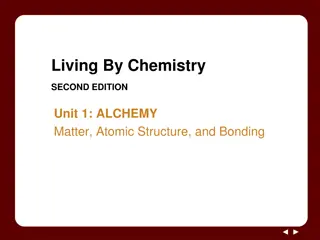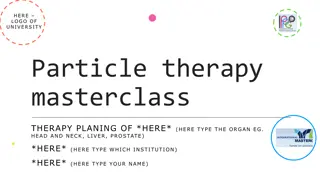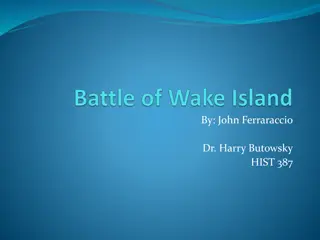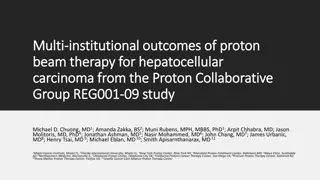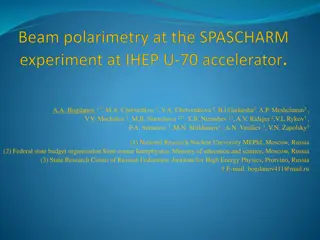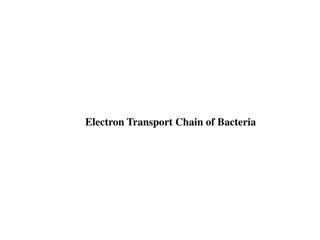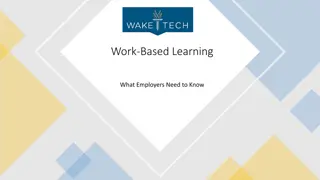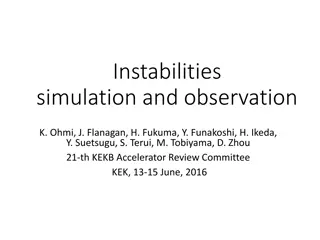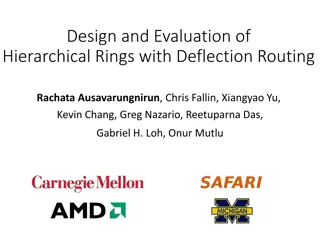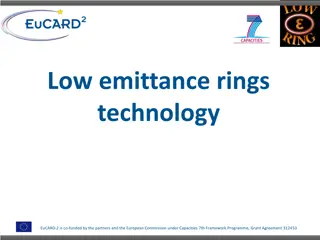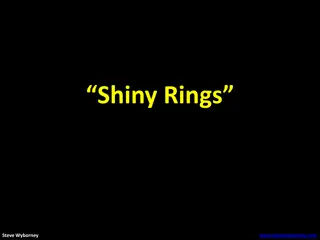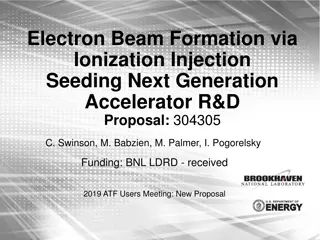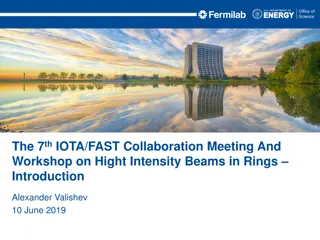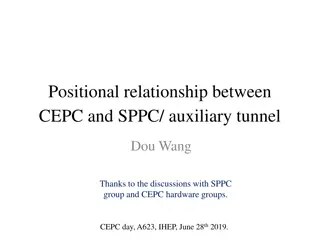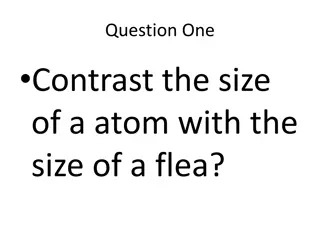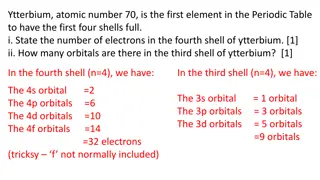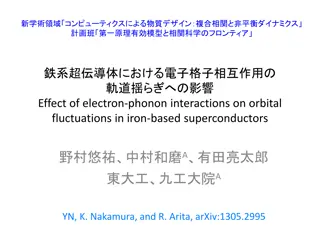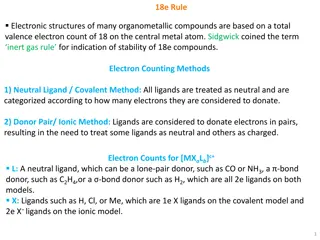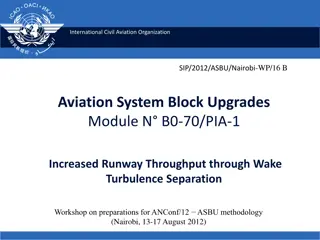Wake Fields and Electron Cloud in High-Intensity Proton Rings
Investigating wake fields and electron cloud phenomena in high-intensity proton rings is crucial for understanding instabilities and improving accelerator science. This involves experimental studies, analyzing instabilities, controlling wake amplitudes, and protecting future machines operating in strong space charge regimes. The research aims to enhance knowledge in beam physics and advance high-energy physics missions.
Download Presentation

Please find below an Image/Link to download the presentation.
The content on the website is provided AS IS for your information and personal use only. It may not be sold, licensed, or shared on other websites without obtaining consent from the author. Download presentation by click this link. If you encounter any issues during the download, it is possible that the publisher has removed the file from their server.
E N D
Presentation Transcript
Electron cloud & Wake fields in high- intensity proton rings Rob Ainsworth HEP GARD Accelerator and Beam Physics: Community-driven Strategic Roadmap Workshop #1 9 December 2019
Outline Topic 1: Experimental studies of wake fields in high intensity ring rings Topic 2: Electron cloud ABP thrusts Grand challenges Related to HEP missions Synergies Roadmap Facilties 09/12/19 2 Rob Ainsworth I HEP GARD ABP: Community-driven Strategic Roadmap Workshop #1
Topic 1 Experimental studies of wake fields in high intensity ring rings 09/12/19 3 Rob Ainsworth I HEP GARD ABP: Community-driven Strategic Roadmap Workshop #1
Understanding instabilities To ensure bunches are stable for future machines - Need to understand what makes them unstable - In particular, single bunch instabilities in the presence of strong space charge Transverse Mode Coupling Instability (TMCI) Convective Instabilities To have a good understanding, need a mix of - Theory - Simulation - Experiments 09/12/19 4 Rob Ainsworth I HEP GARD ABP: Community-driven Strategic Roadmap Workshop #1
Wake-space charge plane Wake amplitude FNAL Recycler/I OTA Space charge parameter 09/12/19 5 Rob Ainsworth I HEP GARD ABP: Community-driven Strategic Roadmap Workshop #1
How to control wake amplitude? Develop a way to control the wake amplitude - Build a system that produces the same kicks to the beam as a Wakefield would - High-bandwidth inter-bunch anti-damper? Machines like FNAL Recycler/IOTA (Non- ramping/long bunches) can be used as a tool to study instabilities in various conditions - Explore wake-space charge plane - Growth rates - Amplification factors 09/12/19 6 Rob Ainsworth I HEP GARD ABP: Community-driven Strategic Roadmap Workshop #1
Impact Improve understanding of accelerator science - Investigate theories experimentally previously limited to only analytical or simulated calculations Protect future machines which operate in the strong space charge regime - High intensity machines - Low to medium energy injectors for colliders 09/12/19 7 Rob Ainsworth I HEP GARD ABP: Community-driven Strategic Roadmap Workshop #1
Whos working on this now? 09/12/19 8 Rob Ainsworth I HEP GARD ABP: Community-driven Strategic Roadmap Workshop #1
Topic 2 Electron cloud 09/12/19 9 Rob Ainsworth I HEP GARD ABP: Community-driven Strategic Roadmap Workshop #1
Electron Cloud E cloud continues to be a problem - Instabilities Fermilab Recycler J-PARC slow extraction - Heat load on cryogenics LHC e-RHIC 09/12/19 10 Rob Ainsworth I HEP GARD ABP: Community-driven Strategic Roadmap Workshop #1
Challenges in prediction Can we realistically predict when e cloud instability will appear in machines? Can simulations quantitively predict heat load? How well do simulations agree with diagnostics? 09/12/19 11 Rob Ainsworth I HEP GARD ABP: Community-driven Strategic Roadmap Workshop #1
Challenges in protection How to protect machines from e cloud? - Low SEY coatings? Amorphous Carbon SS Yichen Ji, 2019 - Laser Ablation Surface Engineered (LASE) surfaces? O. Malyshev et al., 2018 09/12/19 12 Rob Ainsworth I HEP GARD ABP: Community-driven Strategic Roadmap Workshop #1
Challenges in protection How to protect machines from e cloud? - Clearing electrodes? McIntyre, 2005 - Beam manipulations e.g. clearing bunches? Antipov, 2017 09/12/19 13 Rob Ainsworth I HEP GARD ABP: Community-driven Strategic Roadmap Workshop #1
Future direction Improved diagnostics - Fully instrumented magnet for e cloud diagnostics Material studies Low SEY coatings and their long term stability 09/12/19 14 Rob Ainsworth I HEP GARD ABP: Community-driven Strategic Roadmap Workshop #1
Whos working on this now? Many E CLOUD workshop last year - Only 4/64 participants from US institutions In-situ coating at BNL SEY measurement stand in Main Injector 09/12/19 15 Rob Ainsworth I HEP GARD ABP: Community-driven Strategic Roadmap Workshop #1
ABP thrusts Grand challenges Related to HEP missions Synergies Roadmap Facilties 09/12/19 16 Rob Ainsworth I HEP GARD ABP: Community-driven Strategic Roadmap Workshop #1
ABP thrusts Advance physics of accelerators and beams to enable future accelerators. - Will provide unique insight into instabilities previously limited to theory or simulation Guide and help to fully exploit science at the GARD beam facilities and operational accelerators. - Turn existing operational accelerators into tools for studying accelerator science Develop conventional and advanced accelerator concepts and tools to disrupt existing costly technology paradigms in coordination with other GARD thrusts. Educate and train future accelerator physicists. - Both topics require a mix of theory, experimental and simulations 09/12/19 17 Rob Ainsworth I HEP GARD ABP: Community-driven Strategic Roadmap Workshop #1
Grand challenges Both topics feed into grand challenges #1 and #4 Grand challenge #1 (beam intensity): How do we increase beam intensities by orders of magnitude? - Instabilities will limit intensity Grand Challenge #4 (beam prediction): How do we develop predictive virtual particle accelerators ? - To have confidence in predictions, they must be validated by measurements 09/12/19 18 Rob Ainsworth I HEP GARD ABP: Community-driven Strategic Roadmap Workshop #1
HEP missions How is your proposed research related to the HEP-specific missions? Experimental studies of wake fields in high intensity ring rings - Intensity frontier - Energy frontier: hadron Low to medium energy injectors for high energy colliders E-cloud - Intensity - Energy frontier: hadron 09/12/19 19 Rob Ainsworth I HEP GARD ABP: Community-driven Strategic Roadmap Workshop #1
Synergies Describe potential synergies and connections to other GARD thrusts and other SC offices (BES, NP, QIS, FES, etc) Other GARD thrusts - AAC: Both topics require make use of PIC simulations for space charge modeling Other SC offices - NP E cloud in e-RHIC 09/12/19 20 Rob Ainsworth I HEP GARD ABP: Community-driven Strategic Roadmap Workshop #1
Timeline (aka the Roadmap) Wake fields in high intensity rings - Experimental campaign to study instabilities 2020 - 2025 Develop system for exciting instabilities - 2022 Verify excited instability matches expectation - 2023 Measurement program - identify key issues for future machines 2025 - Develop protection systems (feedback) 2025-2030 Electron cloud - Diagnostics development 2020-25 - Material studies 2020-25 Determine protection for future machines 2025-2030 - Low SEY coating or something else? 09/12/19 21 Rob Ainsworth I HEP GARD ABP: Community-driven Strategic Roadmap Workshop #1
Summary Both wake fields and electron cloud have the potential to cause instabilities and prevent facilities fully exploiting their science potential There is much exciting science to be done to prevent this 09/12/19 22 Rob Ainsworth I HEP GARD ABP: Community-driven Strategic Roadmap Workshop #1


